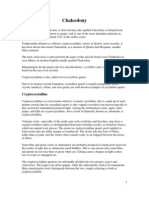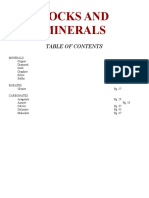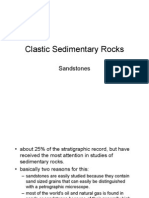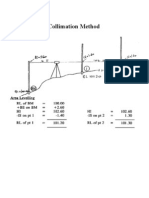Agate Definitions - 2 PDF
Agate Definitions - 2 PDF
Uploaded by
Syarief HidayatCopyright:
Available Formats
Agate Definitions - 2 PDF
Agate Definitions - 2 PDF
Uploaded by
Syarief HidayatOriginal Title
Copyright
Available Formats
Share this document
Did you find this document useful?
Is this content inappropriate?
Copyright:
Available Formats
Agate Definitions - 2 PDF
Agate Definitions - 2 PDF
Uploaded by
Syarief HidayatCopyright:
Available Formats
Agate, Jasper, Opal, Chert and other Related Definitions
Donald Kasper, December 2012, Part 1/2
The author challenges the European definition of agate, jasper, and opal as cryptocrystalline quartz.
Instead, the author defines them defined as:
Amorphous Silicas: The agates, jaspers, and opals are substantially amorphous and are best defined forming with silica gel
chemistry. Their localities, conditions of formation, and structures can be predicted by silica gel chemistry.
C-S-H Gels: The agates, jaspers, and opals form as calcium-silica-hydroxyl gels. Carbonate and silica in hydrated systems form these
rocks. It is the chemical nature of the interaction of carbonate and silica that makes agates and the larger group of calcium-silicate
minerals banded.
N-S-H Gels: Sodium-silica-hydroxyl gels such as magadiite occur in hypersaline systems. Agates, jaspers, and opals cannot form in
environments that are hypersaline. These systems precipitate quartz and silicate minerals, instead.
Rocks: Agates, jaspers, and opals are rocks that at a mineralogical level form in clay-zeolite-silica-hydrate systems. The clays and
zeolites accumulate the alumina and the silica concentration we identify as agate. By far, the number one source of these rocks is
zeolitized volcanic ash. This also means that by far, the number one source of agates, jaspers, and opals is volcanic ash, not lava
voids. The author estimates average travel distance of silica to make agate is 3 inches. They do not form from weathering or
groundwater transport.
Agate: Any silica rock containing at least some fibrous silica layers. A mostly amorphous silica rock consisting of <3% sulfides, <3%
salts (typically <0.7%), <5% iron compounds. The lack of iron tends to make agates translucent, but this is not an important criterion
as agate can be translucent, opaque, or mixed. They contain various amounts of clays and zeolites. Clay inclusions can be expansive
(bentonite, making plumes) or non-expansive (illite, making microspheres). Only illite-bearing agate can form strongly banded
agate; bentonite agate cannot. The minimum silica content for specimens is hard to determine directly, but their source rocks
indicate they should generally be more than 40% silica. Only forms in alkaline systems.
Jasper: An amorphous silica rock consisting of clays and silica. The clay is often illite, a non-expansive clay. It has 5-25% iron
compounds. Less, it is an agate. More it is a banded iron formation rock, an iron ore. All jasper appears to have some translucent
silica regions at a microscopic level but we call it jasper-agate only if the agate is visible to the naked eye. Being opaque is not
sufficient; the rock must contain sufficient iron to make the rock red, yellow, green, purple, or black. This means that non-iron
bearing silica rocks that are opaque are not jasper. Those are often pyroclastic rocks, rhyolite, siliceous sediments, etc. Only forms
in alkaline systems.
Chalcedony: Hydrothermal and volcanic melt exsolution silica deposited in rhyolitic rock fractures and vugs. Often formed as vein
silica. Weakly banded perhaps due to presence of oxides. Has only two colors, white and pink. Thick pink specimens appear
lavender. Translucent. Since this is a niche geologic silica occurrence, the author does not define this as the parent term over agate,
and instead calls agate the parent term.
Opal: An amorphous silica consisting of clays and silica. The clay is presumed to be illite. It generally forms as a hydrate byproduct
of agate and jasper formation, residing as a crust coating nodules of those rocks. It is commonly green from the clay celadonite,
although some identify it as the clay nontronite. Frequently formed on the outside of nodules, with oxygen exposure, it commonly
has manganese dendrites. Unlike the others, opal can form in acid and alkaline systems.
Agate, Jasper, Opal, Chert and other Related Definitions
Donald Kasper, December 2012, Part 2/2
Chert: An amorphous silica rock consisting of clays and silica. This is a silica that formed in saline systems up to 5% salt, shutting
down the normal inclusions and banding found in agates. The silica source for cherts are volcanic ash deposited with carbonates in
ocean sediments from volcanic eruptions. Unlike agates, all cherts form by accretionary deposition, forming nodules. The
cryptocrystalline description of chert comes from microspheres of included cristobalite.
Chert-Agate: An oolitic chert (from cristobalite) where aggregations of concentric banding merge to create localized agate banding
centers.
Flint: An archeological term for chert that can be used to start fires, therefore it contains marcasite and can be considered darker
than chert due to the marcasite.
Figure 1. The Classical European model of agate formation.
By Donald Kasper, 2012
Figure 2. New--A geochemical silicate reaction model of agate formation
By Donald Kasper, 2012
Kaspers Reaction Rule: All agate must form under the 2kbar pressure ceiling, and 575 C temperature wall.
You might also like
- Paediatric Orthopedic Clinic at Children's HospitalDocument9 pagesPaediatric Orthopedic Clinic at Children's HospitalPrashant Pokharel100% (6)
- Bods FunctionsDocument17 pagesBods Functionsvenkateshgunti80% (5)
- Agate DefinitionsDocument1 pageAgate DefinitionsDinda Azkiya AnindhitaNo ratings yet
- Chalcedony 1Document12 pagesChalcedony 1Dinda Azkiya AnindhitaNo ratings yet
- AgateDocument6 pagesAgateMarina Mukadi100% (1)
- Chemical Composition Color: Carbonate MineralsDocument4 pagesChemical Composition Color: Carbonate MineralsCarmemNo ratings yet
- Rock TypesDocument33 pagesRock Typesmostafahawa4No ratings yet
- Agate: For Other Uses, SeeDocument6 pagesAgate: For Other Uses, SeeGabi MarianaNo ratings yet
- Study of Rock-Forming MineralsDocument50 pagesStudy of Rock-Forming MineralsAlmira Legion PisngotNo ratings yet
- Classification of Igneous RockDocument32 pagesClassification of Igneous RockNitesh-02100% (1)
- Batuan Sedimen KimiawiDocument16 pagesBatuan Sedimen KimiawiMalik MajidNo ratings yet
- Science Class Presentation in Pink Blue Flat Graphic StyleDocument63 pagesScience Class Presentation in Pink Blue Flat Graphic StyleGdeity PlaysNo ratings yet
- Igneous Rock ClassificationDocument23 pagesIgneous Rock ClassificationOgina Lamenta-AbuanNo ratings yet
- SeleniteDocument6 pagesSelenitecpunxzatawneyNo ratings yet
- Feldspar (Sandeep)Document25 pagesFeldspar (Sandeep)debasish mahantaNo ratings yet
- 9 Silicates (GL 204 My Lecture) - HandoutDocument19 pages9 Silicates (GL 204 My Lecture) - HandoutStanliNo ratings yet
- Yenite: Syenite Is Intrusive Igneous Rock That Basically Composed of An Alkali Feldspar and ADocument9 pagesYenite: Syenite Is Intrusive Igneous Rock That Basically Composed of An Alkali Feldspar and AArah Louise ApostolNo ratings yet
- Rocks and Minerals - 1405305940Document224 pagesRocks and Minerals - 1405305940Anyak2014100% (6)
- Lesson 5Document18 pagesLesson 5macalaalnor93No ratings yet
- Geology Chapter 2Document43 pagesGeology Chapter 2135jansendalawampuNo ratings yet
- EESC 2100-LAB4-SED2-F11-Common Mineral in Sedimentary RocksDocument7 pagesEESC 2100-LAB4-SED2-F11-Common Mineral in Sedimentary RocksTak Punya NamaNo ratings yet
- Mineral ADocument42 pagesMineral ASetya WibawaNo ratings yet
- 8th MineralogyDocument13 pages8th MineralogyselvimisniairawatiNo ratings yet
- Rocks and MineralsDocument85 pagesRocks and MineralsRowena LupacNo ratings yet
- ROCKS ... and How To Identify ThemDocument52 pagesROCKS ... and How To Identify Themvasu7900100% (2)
- Minerals & RocksDocument2 pagesMinerals & Rocksapi-3808551No ratings yet
- Term Paper About RocksDocument6 pagesTerm Paper About Rocksafmzxutkxdkdam100% (1)
- Feldspar Family: By: Divine Grace A. ViernesDocument9 pagesFeldspar Family: By: Divine Grace A. ViernesRizette PaloganNo ratings yet
- Document 5Document14 pagesDocument 5Piyush YadavNo ratings yet
- Earth Sciences Notes Csir-Ugc Net JRFDocument57 pagesEarth Sciences Notes Csir-Ugc Net JRFmanas773No ratings yet
- BBLB Mohs Scale HardnessDocument5 pagesBBLB Mohs Scale HardnessMomo KomoNo ratings yet
- FeldsparDocument11 pagesFeldsparمحمد حسينNo ratings yet
- Lecture 3 Rock-Forming MineralsDocument25 pagesLecture 3 Rock-Forming MineralsMiguel FeijaoNo ratings yet
- Anhydrite: Anhydrite Is A Mineral - AnhydrousDocument5 pagesAnhydrite: Anhydrite Is A Mineral - AnhydroustalatbilalNo ratings yet
- Rocks and MineralsDocument40 pagesRocks and MineralsfinNo ratings yet
- Igneous RocksDocument13 pagesIgneous RocksVanshika SalviNo ratings yet
- List of The Rock-Forming MineralsDocument20 pagesList of The Rock-Forming Mineralsroshan_geo07889667% (3)
- Semi-Precious Stones - A Historical Article on Agate, Amber, Amethyst and Many Other Varieties of GemstonesFrom EverandSemi-Precious Stones - A Historical Article on Agate, Amber, Amethyst and Many Other Varieties of GemstonesRating: 5 out of 5 stars5/5 (1)
- Economic lab 5Document12 pagesEconomic lab 5malketbi175No ratings yet
- MarbleDocument6 pagesMarbleGuvernanta IdealaNo ratings yet
- Algodonite Value, Price, and Jewelry Information - Gem SocietyDocument6 pagesAlgodonite Value, Price, and Jewelry Information - Gem Societyasset68No ratings yet
- CHE882Unit3 L13Document8 pagesCHE882Unit3 L13akshatpathak04032002No ratings yet
- SulfurDocument10 pagesSulfurRanaAttiqahNo ratings yet
- KristMin01 PengantarDocument66 pagesKristMin01 Pengantarmelvinda putriNo ratings yet
- Arkansas Quartz Crystals: A.G.E.S. Brochure Series 001Document8 pagesArkansas Quartz Crystals: A.G.E.S. Brochure Series 001jamey whiteNo ratings yet
- MineralogyDocument27 pagesMineralogyamber19995100% (1)
- EPS 50 Lab 4: Sedimentary Rocks: Grotzinger and Jordan, Chapter 5Document7 pagesEPS 50 Lab 4: Sedimentary Rocks: Grotzinger and Jordan, Chapter 5Abood BuriahiNo ratings yet
- Lec 14Document18 pagesLec 14My Maths SupportNo ratings yet
- 2005 Lecture 3 Sand StonesDocument18 pages2005 Lecture 3 Sand StonesPrasanti Plaban DashNo ratings yet
- Models For Volcanic-Hosted Epithermal Precious Metal Deposits A ReviewDocument11 pagesModels For Volcanic-Hosted Epithermal Precious Metal Deposits A ReviewOrlando B Santa Cruz100% (1)
- Ruby Gemstones - A Collection of Historical Articles on the Origins, Structure and Properties of the RubyFrom EverandRuby Gemstones - A Collection of Historical Articles on the Origins, Structure and Properties of the RubyRating: 5 out of 5 stars5/5 (1)
- Little Rocks & Small Minerals! | Rocks And Mineral Books for Kids | Children's Rocks & Minerals BooksFrom EverandLittle Rocks & Small Minerals! | Rocks And Mineral Books for Kids | Children's Rocks & Minerals BooksRating: 4 out of 5 stars4/5 (1)
- Faceted Gems - A Historical Article on the Methods and Equipment Used in LapidaryFrom EverandFaceted Gems - A Historical Article on the Methods and Equipment Used in LapidaryNo ratings yet
- The Cutting, Setting and Engraving of Precious Stones - A Historical Article on Working GemstonesFrom EverandThe Cutting, Setting and Engraving of Precious Stones - A Historical Article on Working GemstonesNo ratings yet
- The Elements of Geology; Adapted to the Use of Schools and CollegesFrom EverandThe Elements of Geology; Adapted to the Use of Schools and CollegesNo ratings yet
- Emerald Gemstones - A Collection of Historical Articles on the Origins, Structure, Properties and Uses of EmeraldsFrom EverandEmerald Gemstones - A Collection of Historical Articles on the Origins, Structure, Properties and Uses of EmeraldsNo ratings yet
- Cambridge Assessment International Education: Economics 9708/12 March 2019Document3 pagesCambridge Assessment International Education: Economics 9708/12 March 2019MAOYUAN LINo ratings yet
- 0625 - s22 - QP - 4 (Extended) 1 PDFDocument16 pages0625 - s22 - QP - 4 (Extended) 1 PDFJoey DingNo ratings yet
- Railway FastenerDocument3 pagesRailway FastenerHany KusumawatiNo ratings yet
- 4 - PH Art HistoryDocument2 pages4 - PH Art Historymaricar basilanNo ratings yet
- PRC Form 104Document1 pagePRC Form 104Ber Salazar Jr100% (7)
- Agricultural Extension Service Delivery ApproachesDocument4 pagesAgricultural Extension Service Delivery ApproachesTestNo ratings yet
- Reuse and Salvage For 3500, 3600 & C175 Engine Oil PansDocument56 pagesReuse and Salvage For 3500, 3600 & C175 Engine Oil Pansma.powersourceNo ratings yet
- 166 194 1 PBDocument5 pages166 194 1 PBnovitalumintusariNo ratings yet
- Omron SYSMAC-C Series: Bit DeviceDocument6 pagesOmron SYSMAC-C Series: Bit DeviceJeydson StorchNo ratings yet
- Agenda: Blockers (Risks, Issues, Assumptions, Dependencies)Document7 pagesAgenda: Blockers (Risks, Issues, Assumptions, Dependencies)anarki85No ratings yet
- PublishedDocument26 pagesPublishedScribd Government DocsNo ratings yet
- Basin Development and Tectonic History of Llanos Eastern Cordillera and Mid Magdalena Valley Cooper 37Document23 pagesBasin Development and Tectonic History of Llanos Eastern Cordillera and Mid Magdalena Valley Cooper 37Carlos Andres RojasNo ratings yet
- OIM - Connector Guide For BMC RemedyDocument74 pagesOIM - Connector Guide For BMC RemedyCarlos FaganelloNo ratings yet
- Leveling Height of Colimation MethodDocument7 pagesLeveling Height of Colimation Methodjoenew2000No ratings yet
- Chem 1140 Ring-Closing Metathesis (RCM) and Ring-Opening Metathesis (ROMP)Document26 pagesChem 1140 Ring-Closing Metathesis (RCM) and Ring-Opening Metathesis (ROMP)Abhishek GuddadNo ratings yet
- India's Growth StoryDocument56 pagesIndia's Growth StorySwami GurunandNo ratings yet
- Monitoring Tool - Learner Formation ProgramsDocument3 pagesMonitoring Tool - Learner Formation ProgramsClarissa HugasanNo ratings yet
- International Journal of Energy and Environmental Engineering - A SpringerOpen JournalDocument12 pagesInternational Journal of Energy and Environmental Engineering - A SpringerOpen Journalsharmasrish143No ratings yet
- Woodward Governor'S Troubleshooting and Rectification: A Case On Jamuna Fertilizer Company PerspectiveDocument0 pagesWoodward Governor'S Troubleshooting and Rectification: A Case On Jamuna Fertilizer Company PerspectiveSofiane HalimiNo ratings yet
- Echnical Ulletin: Model: Date: No.: Subject: Prepared By: From: ClassificationDocument100 pagesEchnical Ulletin: Model: Date: No.: Subject: Prepared By: From: Classificationmaxi iliescuNo ratings yet
- Spwla1980 P Raymer Hun Tgardner PDFDocument13 pagesSpwla1980 P Raymer Hun Tgardner PDFShyh-Zung LoNo ratings yet
- An Illustrated Guide To IPsecDocument19 pagesAn Illustrated Guide To IPsecwouterNo ratings yet
- Nissan Murano Z50 2002-2008 MaintenanceDocument34 pagesNissan Murano Z50 2002-2008 MaintenancejuanNo ratings yet
- Intro To SQLDocument15 pagesIntro To SQLmoustaphahassaan584No ratings yet
- SM 1 PDFDocument148 pagesSM 1 PDFAkash JainNo ratings yet
- ResumealtheachansaiDocument7 pagesResumealtheachansaiJasher JoseNo ratings yet
- Pressure Vs StressDocument2 pagesPressure Vs StressMustapha SedikNo ratings yet
- Finon Week2 Financial SystemDocument27 pagesFinon Week2 Financial SystemAebilTaskari RNo ratings yet

























































































